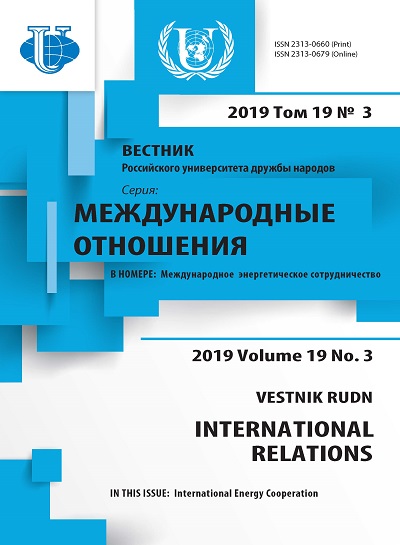Экономическая политика Индонезии и перспективы российско-индонезийского торгово-экономического сотрудничества
- Авторы: Сибарани Д.М.1
-
Учреждения:
- Российский университет дружбы народов
- Выпуск: Том 19, № 3 (2019): Международное энергетическое сотрудничество
- Страницы: 450-462
- Раздел: ДВУСТОРОННИЕ ОТНОШЕНИЯ
- URL: https://journals.rudn.ru/international-relations/article/view/22594
- DOI: https://doi.org/10.22363/2313-0660-2019-19-3-450-462
- ID: 22594
Цитировать
Полный текст
Аннотация
Статья посвящена современной экономической ситуации в Индонезии и перспективам российско-индонезийского экономического сотрудничества. Автор рассматривает экономическое развитие Индонезии с 1998 г. - после азиатского экономического кризиса, внутриэкономическую повестку и политику нынешнего президента страны Д. Видодо, а также историю и потенциал дальнейшего развития торгово-экономических отношений между Россией и Индонезией. Актуальность выбранной темы определяется все более возрастающей ролью Индонезии в международной политике в XXI в. Это четвертая по численности населения страна после Китая, Индии и Соединенных Штатов. Ее экономика занимает 16-е место в мире и первое - в АСЕАН. Индонезия - член большой двадцатки. Эксперты прогнозируют, что к 2030 г. Индонезия войдет в пятерку самых крупных экономик мира. Для России развитие отношений с быстроразвивающимися странами Азии является важной составляющей ее внешней политики по диверсификации торговых партнеров и выходу на перспективные рынки развивающихся стран. Основной целью статьи является исследование актуальных проблем, с которыми столкнулось правительство Индонезии при реализации новой экономической политики, для выявления перспективных направлений сотрудничества России с Индонезией в условиях экономических санкций со стороны Запада в отношении России и активизации российской внешней политики на Востоке. В статье выявляются потенциал этих отношений и выгоды для российской и индонезийской экономики. В процессе исследования автор использовал исторический метод, который позволил проанализировать развитие и состояние современной экономической ситуации в Индонезии и установить перспективы российско-индонезийских отношений. При рассмотрении внутриэкономической ситуации в Индонезии был применен метод сравнительного анализа, позволивший сформулировать выводы о достижениях экономической политики правительства Индонезии. Автор выявляет перспективные направления дальнейшего развития российско-индонезийских торгово-экономических отношений с учетом нужд современной индонезийской экономической повестки дня.
Об авторах
Даме Мария-Нова Сибарани
Российский университет дружбы народов
Автор, ответственный за переписку.
Email: 1042175034@rudn.ru
аспирант кафедры теории и истории международных отношений
Москва, Российская ФедерацияСписок литературы
- Другов А.Ю. Индонезия в 2006 г. Стабилизация в экономике и разногласия в элите // Юго-Восточная Азия: актуальные проблемы развития. 2007. № 10. С. 190-212.
- Другов А.Ю. Россия - Индонезия: «приливы и отливы» // Азия и Африка сегодня. 2009. № 12. С. 5-12.
- Ефимова Л.М. Внешнеполитическая доктрина президента Индонезии Джоко Видодо // Юго-Восточная Азия: актуальные проблемы развития. 2016. № 33. С. 55-69.
- Ефимова Л.М. Внешнеполитический процесс в Индонезии // Вестник МГИМО-Университета. 2010. № 1 (10). С. 202-211.
- Ефимова Л.М. Российско-индонезийские отношения в XXI веке // Международные отношения. 2014. № 37 (4). С. 73-81.
- Сабон В.Л. Развитие торгово-экономического сотрудничества между Россией и Индонезией // Вестник Российского университета дружбы народов. Серия: Экономика. 2012. № 1. С. 41-48.
- Хохлова Н.И. Основные направления внешней политики Индонезии и перспективы ее развития по итогам первого президентства С.Б. Юдойоно // Вестник МГИМО-Университета. 2011. № 4 (19). С. 54-60.
- Хохлова Н.И. Отношения России и Индонезии на современном этапе // Юго-Восточная Азия: актуальные проблемы развития. 2018. Т. 2. № 2 (18). С. 99-105
- Boediono. Managing the Indonesian Economy: Some Lessons from the Past // Bulletin of Indonesian Economic Studies. 2005. Vol. 41. No. 3. P. 309-324
- Cornot-Gandolphe S. Indonesia’s Electricity Demand and the Coal Sector: Export or meet domestic demand? // Oxford Institute for Energy Studies. March 2017. URL: https://www.oxfordenergy.org/wpcms/wp-content/uploads/2017/03/ Indonesias-Electricity-Demand-and-the-Coal-Sector-Export-or-meet-domestic-demand-CL-5.pdf (accessed: 21.11.2018)
- Elias S., Noone C. The Growth and Development of the Indonesian Economy // Reserve Bank of Australia Bulletin. 2011. P. 33-43
- Hamilton-Hart N., Schulze G. Taxing Times in Indonesia: The Challenge of Restoring Competitiveness and the Search for Fiscal Space // Bulletin of Indonesian Economic Studies. 2016. Vol. 52. No. 3. P. 265-295
- Kurniawan R., Managi S. Economic Growth and Sustainable Development in Indonesia: An Assessment // Bulletin of Indonesian Economic Studies. 2018. Vol. 54. No. 3. P. 339-361. doi: 10.1080/00074918.2018.1450962
- Nugroho A. E. Trade Policies and the Export Performance of Indonesia, 1983-1997 // The Winners. 2001. Vol. 2. No. 1. P. 38-46
- Pangestu M., Rahardja S., Ing L.Y. Fifty Years of Trade Policy in Indonesia: New World Trade, Old Treatments // Bulletin of Indonesian Economic Studies. 2015. Vol. 51. No. 2. P. 239-261
- Pardede R., Zahro S. Saving not Spending: Indonesia’s Domestic Demand Problem // Bulletin of Indonesian Economic Studies. 2017. Vol. 53. No. 3. P. 233-259
- Patunru A.A., Rahardja S. Trade Protectionism in Indonesia: Bad Times and Bad Policy. Sydney: Lowy Institute, 2015
- Rajah R. Indonesia’s Economy: Between Growth and Stability // Lowy Institute. 15 August, 2018. URL: https://www.lowyinstitute.org/publications/indonesia-economy-between-growth-and-stability (accessed: 20.11.2018)
- Ray D., Ing L.Y. Addressing Indonesia’s Infrastructure Deficit // Bulletin of Indonesian Economic Studies. 2016. Vol. 52. No. 1. P. 1-25
- Resosudarmo B.P., Abdurohman. Is Being Stuck with a Five Percent Growth Rate a New Normal for Indonesia? // Bulletin of Indonesian Economic Studies. 2018. Vol. 54. No. 2. P. 141-164
- Robison R., Hadiz V.R. Indonesia: A Tale of Misplaced Expectations // The Pacific Review. 2017. Vol. 30. No. 6. P. 895-909
- Rock M.T. Indonesia’s Centripetal Democracy and Economic Growth // Journal of the Asia Pacific Economy. 2018. Vol. 23. P. 156-172
- Touwen J. The Economic History of Indonesia // Economic History Association. 2008. URL: https://eh.net/encyclopedia/ the-economic-history-of-indonesia/ (accessed: 20.11.2018)
Дополнительные файлы










